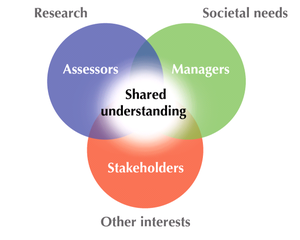Shared understanding
| Moderator:Jouni (see all) |
| This page is a stub. You may improve it into a full page. |
| Upload data
|

<section begin=glossary />
- Shared understanding between two individuals about a particular topic means a situation where each individual is able to correctly explain what the other thinks about the topic and why. This definition can be extended also to a larger group. Here shared understanding is a written description of the topic that covers the thinking and reasoning on the topic of all members. In this group setting, not everyone needs to be able to describe everyone else's thinking, but everyone should agree that the written description correctly contains their thinking about the topic. In this way, although not everything is known by everyone in the group, the written description effectively represents the shared understanding of the group. Importantly, online tools such as wikis can be used to develop shared understanding even about complex topics among large groups.
- It is important to notice that shared understanding is not the same as consensus or agreement. In shared understanding people can still disagree on the topic, but they agree on what opinions there are about it. While the purpose of agreement in decision-making is to conclude about the best option and act based on it, the purpose of shared understanding is to identify one or more poor decision option that should be rejected. This is analogous to the scientific method. Instead of attempting to find the truth directly, it critically evaluates hypotheses and rejects all that are not plausible in the light of observations. As the scientific method has proved to be the best method known for developing knowledge about the world, shared understanding may prove to be an effective way to make public policy.
<section end=glossary />
Question
How can shared understanding be reached within a self-organised group?
How can shared understanding be used to improve societal decision-making?
Answer
- Divide complex topics into smaller ones with a clear research questions (typically variables).
- Apply discussion rules to resolve disputes.
- Remember that the objective is not to find a single solution but rather to describe the variety of opinions.
- However, implausible things should not be accepted. If A and B can be shown to be incompatible, the conclusion is "A or B but not both." Even if some individual thinks "A and B", this is not accepted in the shared understanding.
- In policy discussions, you can demand shared understanding from your decision-maker e.g. in this way: "Although you have the power to make this decision that affects me, I have the right to see shared understanding on this topic. Explain me why I think your plan is stupid and why you still want to do it."
- Policy pressure should be put on rejecting policies that are found poor by shared understanding. Spread the word in media about why it is poor and how anyone can learn about the shared understanding on it.
Acceptability
Acceptability can be measured with a test of shared understanding. In a decision situation there is shared understanding when all participants of the decision support or decision making process will give positive answers to the following questions.
| Question | Who is asked? |
|---|---|
| Is all relevant and important information described? | All participants of the decision support or decision making processes. |
| Are all relevant and important value judgements described? | |
| Are the decision maker's decision criteria described? | |
| Is the decision maker's rationale from the criteria to the decision described? |
Rationale
Shared understanding is an ambitious idea about how decision making can be dramatically improved from the current situation in Western countries by increasing sharing and understanding at the same time. It is not enough that there exists a policy advisory expert who understands the very details of a complex policy problem and its solutions and gives recommendations to policy makers. Anyone in the society should have a possibility to learn those things from open information sources and make own conclusions about good solutions. These information sources should be organised in a way that they start from main conclusions and proceed towards more detailed and technical rationale; people must be able to understand the issues without becoming experts first. [1] [2]
Recently, an active movement for open public data has emerged in many European countries and the US. However, it is not enough that all data is available for anyone. This shared data should be developed into information and then into understanding, i.e. into descriptions about how things are and what our options are in developing the society. Opening up and sharing raw data is just a step in a long process of increasing the understanding of a people.
See also
- Looking beyond borders: Integrating best practices in benefit–risk analysis into the field of Food and Nutrition
- Evaluating effectiveness of open assessments on alternative biofuel sources
- File:Shared understanding.png
- File:Look3.JPG
Keywords
References
- ↑ Sandström, Vilma; Tuomisto, Jouni T.; Majaniemi, Sami; Rintala, Teemu; Pohjola, Mikko V.: Evaluating effectiveness of open assessments on alternative biofuel sources. Sustainability: Science, Practice & Policy (2014): 10(1) Published online May 16, 2014. [1]
- ↑ M.J. Tijhuis, M.V. Pohjola, H. Gunnlaugsdóttir, N. Kalogeras, O. Leino, J.M. Luteijn, S.H. Magnússon, G. Odekerken-Schröder, M. Poto, J.T. Tuomisto, Ø. Ueland, B.C. White, F. Holm, H. Verhagen: Looking beyond borders: Integrating best practices in benefit–risk analysis into the field of Food and Nutrition. Food and Chemical Toxicology 50 (2012) 77–93 doi:doi:10.1016/j.fct.2011.11.044 .
About common understanding (joint sensemaking): Boin, A., & Renaud, C. (2013). Orchestrating Joint Sensemaking Across Government Levels: Challenges and Requirements for Crisis Leadership. Journal of Leadership Studies, 7(3), 41-46.
Related files
<mfanonymousfilelist></mfanonymousfilelist>